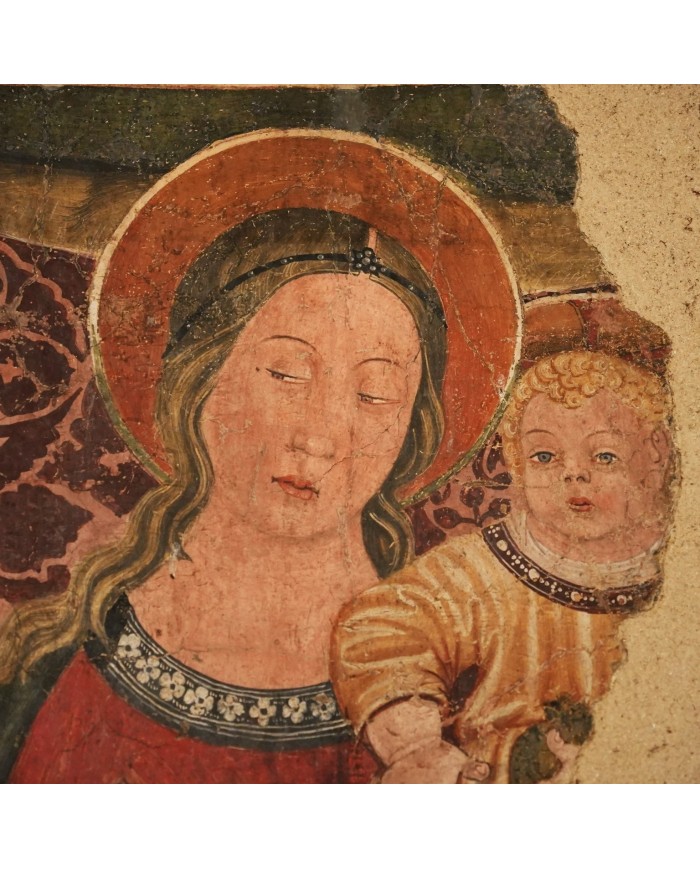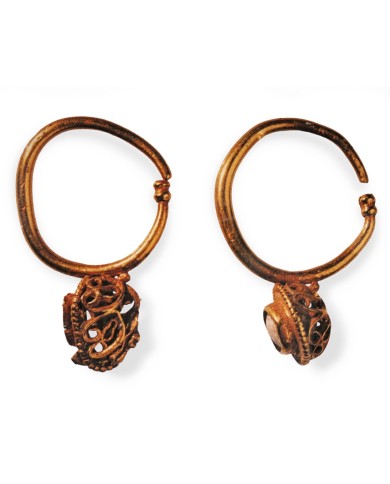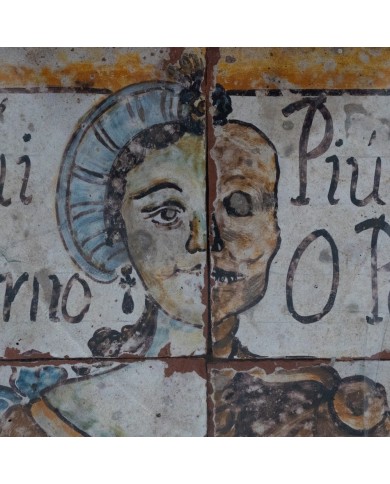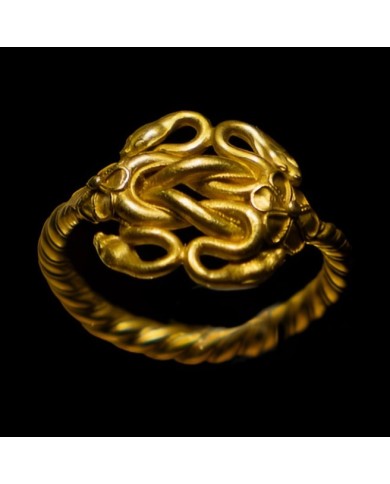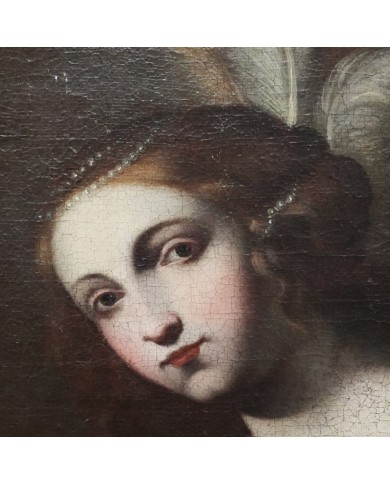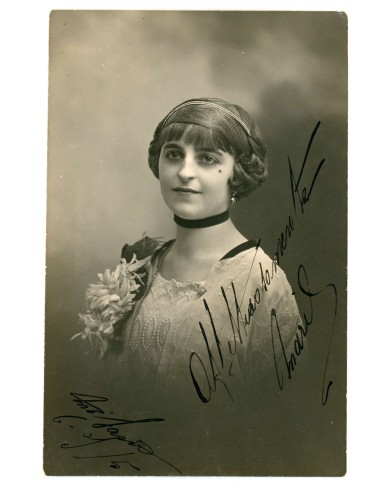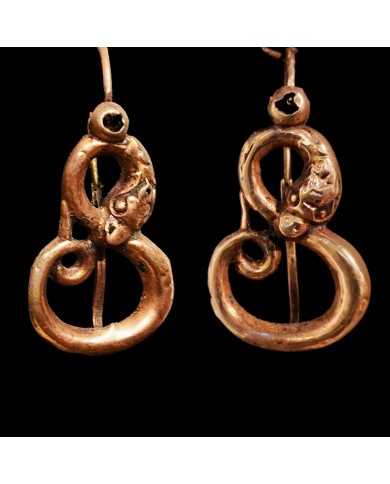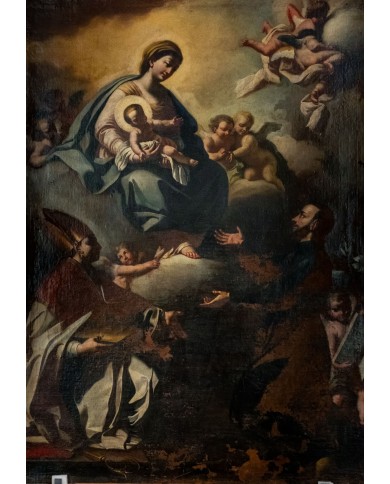The hairstyle of the Virgin of Laurito
When one arrives in Laurito, the attentive eye cannot fail to appreciate the road through the town, which has preserved its stone paving, which is unusual and exceptional, also in view of the fact that it is part of the old State Highway 18 - Tirrena Inferiore - the main road linking Reggio Calabria to Naples along the Tyrrhenian coast, which was only supplanted in 1967 with the opening of the first section of the Salerno-Reggio Calabria motorway as far as Lagonegro, in 1969 Cosenza and the following year Gioia Tauro. The motorway no longer crossed the Cilento area, however, but travelled along another route, still passing through the Cilento, Vallo di Diano and Alburni National Park, but essentially taking over the Calabrian State Highway 19, which crosses the southern Apennines, partially following the route of the Capua-Reghium consular road, the so-called Via Popilia, named after the Roman consul who built it, as testified by the Polla tombstone dating back to the second century BC. From pastoral visits diligently reported by Pietro Ebner, we know that in 1902 Bishop Jacuzio arrived in Laurito 'in curribus', i.e. in a coach, travelling along State Road 18, which was only called this in 1928, having previously been titled Strada Regia delle Calabrie (Royal Road of Calabria), taking 4 hours.
Travelling by carriage or coach was a common experience for many Italians in the first decades of the 20th century. Those who could afford it used their own carriage or a rented buggy pulled by one or two horses, while those who had fewer means relied on coachmen, who transported people and goods with carts or wagons pulled by donkeys or mules. These vehicles were slower and less comfortable, but also cheaper and more durable. The regulation of the circulation of animal-drawn vehicles in Italy in the early 1900s was rather patchy and varied between regions and municipalities. One of the first regulations on the subject was Law No. 2248 of 20 March 1865, which established certain rules on speed and correct behaviour for drivers of animal-drawn vehicles. In particular, the law stipulated that there was a need for a licence issued by the Sindac, that the maximum speed allowed was 10 kilometres per hour in towns and 15 kilometres per hour in the countryside, unless otherwise stipulated by the local authorities, that one had to keep to the right, and that one had to take care of one's animals and not subject them to suffering or mistreatment. This last aspect we like to highlight in this our journey through Cilento through the eyes of the goldsmith, since our patron saint, Saint Eligius the Bishop, is also the protector of farriers and equines. When Bishop Jacuzio arrived in Laurito on the paved road that today is called Corso Umberto I, he found a different scenery than the one we see today. As these period pictures testify, at that time there were several towers, such as the imposing corner tower (of the no longer existing palace of the Monforte family, Laurito's suffeudatory) or the tower of the family palace in Pecorelli, occupying part of the public street, demolished at the end of the 19th century to make room for the new Cuccaro-Sanza road. Or the clock tower of the palazzo del Decurionato - which in the 19th century was the town government - demolished during Fascism to rebuild a new town hall, also with a tower, later demolished following the 1980 earthquake, leaving the square as we see it today.
FOTO BIANCO E NERO TORRI
The pastoral visits reported by Pietro Ebner tell of a further coach trip by Bishop Jacuzio to Laurito, in 1911, where we find a small description of the church of San Filippo d'Agyra, a Sicilian bishop and martyr and the patron saint of the village. The church contains a Gothic chapel, predating the church itself that later incorporated it, inside which there are fascinating and very interesting frescoes that we will now dwell on.
"In hac ecclesia exstant aliquae picturae super parietibus quae, uti dicitur, valent multo ac vetustae sunt, forsan tempore dominii graecorum effectae fuere"
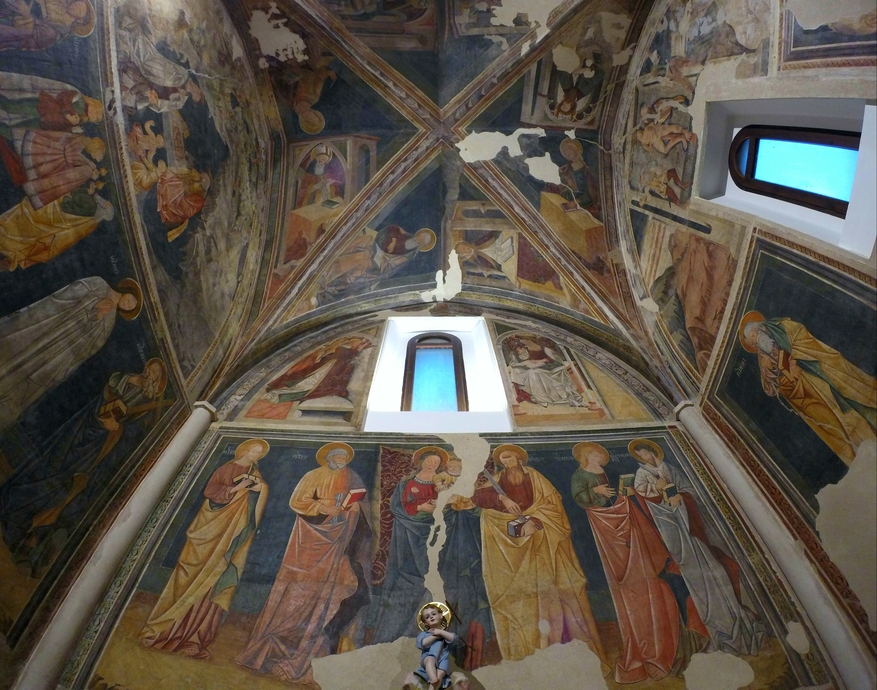
These ancient frescoes of great value are traced by the verbalist back to the time of the Italo-Greek monks, when the territory was not Latinised the Christianity of these lands and of the south looked to the east, from where the Italo-Greek monks who settled in Cilento came, many of them first passing through Sicily from which they fled in the 9th century with the Saracen invasions, as was probably the case with the Christian community of the town of Agira, which came here and settled and gave birth to the town we know today as Laurito. The first documented mention of 'in loco laurito' is a parchment from 947 that deals precisely with donations linked to the presence of Italo-Greek monks. Nevertheless, the frescoes are not from the Byzantine period, but were painted at the end of the 15th century and could be the work of a local painter. In the frescoes we also find the patronage, represented in the figures of the Magi placed between St. James the Greater and St. James the Less, which could be ascribed to the feudal lord of the time, Jacobello Monforte.
The frescoes are divided into two registers: the lower one presents the series of the Apostles on a blue background, interrupted in the centre by the Madonna of the Milk, on which we will focus shortly; the upper one presents three scenes from the New Testament: the Nativity, the Annunciation and the Flagellation; and finally, the sails of the cross vault are decorated with the figures of the Doctors of the Church.
The Virgo lactans is framed in a purple damask drape with plant motifs, the same background we find in the other representation of the Virgin that we return to here, that of the Annunciation. The Madonna of the Milk, with her powder-blue mantle emerging in her divine regality, has a high-waisted dress in carmine red, with a bandeau on the barely pronounced neckline, all lace-like stitched and embellished with silver threads in quadrilobed motifs. Similar decoration also appears on the robes of the child but with cruciform motifs.
La Virgo lactans è incorniciata in un drappo damascato porpora con motivi vegetali, lo stesso fondo che troviamo nell'altra rappresentazione della Vergine che qui torniamo, quella dell'Annunciazione. La Madonna del Latte, col suo manto azzurro polvere emerge nella sua regalità divina, ha un abito con vita alta in rosso carminio, con un bandeau sulla scollatura appena pronunciata, tutto merlettato come una trina cucita ed impreziosita di fili argentei a motivi quadrilobati. Simile decorazione appare anche sulle vesti del bambino ma con motivi cruciformi.
FOTO PARTICOLARE VERGINE
Nel periodo tardomedievale fino al gotico e poi nel Rinascimento vi era una grande attenzione al capo delle donne. La testa era affermazione di bellezza, una bellezza esteriore e interiore,dove anzi la bellezza interiore veniva riflessa da quella esteriore.
Perciò si soleva scoprire la fronte e lasciar vedere la pelle bianca e le guance rosse, espressione di gentilezza e virtù morali. Di gran moda le carnagioni chiare e i capelli biondi o rossi tanto da influenzare le donne dei secoli successivi a sottoporsi ad innumerevole torture per modificare il proprio aspetto, a modificare la propria carnagione e il colore di capelli con impacchi e tinture naturali come zafferano, radice di liquirizia e finanche l'uso della calce per sbiancare le pelli. Di gran moda erano anche le acconciature sciolte libere da strutture o grandi ornamenti.
In particolare modo per le donne sposate o appartenenti ad un ceto sociale alto.
Per le fanciulle non spose o le popolane i capelli andavano raccolti in retine o copricapi in lino o cuffie e veli detti anche "panicelli"
Abbandonata ormai la pratica dello scorticatolo che prevedeva l'epilazione della fronte ,il viso ritrova una rinnovata naturalezza e candore, esaltato ancora di più da una marcata fila al centro, una scriminatura centrale che divideva in due le chiome.
Come nel caso della Madonna di Laurito.
Il suo capo è sovrastato da una cerchia aurea e in testa porta sulla capigliatura una banda che cinge la capigliatura sciolta con fila al centro del capo.
Poteva essere un laccio impreziosito con al centro una rosetta a 5 petali dati da margaritas cioè da perle le stesse perle si ripetono lungo tutto il laccio distanziate fra di loro.
Questi tipi di lacci o stringhe che presero il nome poi nel secolo successivo come "ferronière" dal famoso dipinto di Madame Ferron di Leonardo da Vinci, furono uno degli ornamenti più utilizzati sia da donne che da uomini, come vediamo sul capo dell' arcangelo infatti.
Queste lenze potevano essere di seta, di velluto e servivano a valorizzare proprio la riga marcata fra i capelli e nella parte dove la fila incontrava la fronte per conferire ulteriore luminosità si fissavano delle perle, dei diamanti o altri elementi decorativi.
Giuditta Pace, Laurito un paese del Cilento, GAL Casacastra (2014);
Silvia De Luca, Gli affreschi in San Filippo d'Agyra nel contesto della pittura cilentana della seconda metà del XV secolo, appendice in Giuditta Pace, Laurito un paese del Cilento, GAL Casacastra (2014);
Silvia De Luca, Il maestro dell'Incoronazione di Eboli, ovvero Pavanimo Panormita, in PARAGONE Rivista mensile di arte figurativa e letteratura fondata da Roberto Longhi, Anno LXXI - Terza serie - Numero 152 (845) Luglio 2020;
Amedeo La Greca, Antonio Capano, Giovanna Baldo, Laurito. Note di Storia antica e moderna, Edizioni del Centro di Promozione Culturale per il Cilento (2014)
Jole Mazzoleni, Notizie per la storia di Laurito e della famiglia Monforte (1344-1770), in Rassegna Storica Salernitana (1951)

